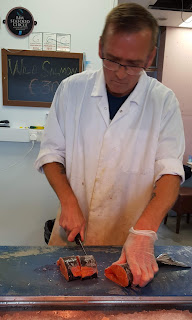 |
| It's in the bag!...the blood, that is. |
Earliest recipes used cow or sheep's blood, but by the 19th century pig's blood was predominantly used. I love Pinhead Oats so used them as the thickener.
 |
| Steel-cut pinhead Irish oats are made from whole oat groats that have been cut into 2 or 3 pieces making for a much chewier cereal. |
 |
| This is the 10 liter bucket the blood came in. |
 |
| I'm filtering the blood in our garage kitchen. |
Blood has a short shelf life (approximately 48 hours from time of harvesting, although my butcher said it lasts up to a week if kept very cold) so I wanted to get what I wasn't using into the freezer right away. Here's the recipe...
Ingredients:
4 cups fresh pigs blood
2 1/2 tsp. Salt, divided
1 1/2 cup steel-cut Pinhead Oatmeal
2 cups finely diced pork fat or beef suet. I used pork.
1 large yellow onion, finely chopped
1 large clove garlic, finely minced
1 cup milk
1 1/2 tsp. Freshly ground black pepper
1 tsp. Allspice
1 tsp. Dried thyme
 |
| Dicing the pork fat. |
Preheat oven to 325 degrees and grease 3 glass loaf pans. The recipe I used recommended lining a metal pan with parchment if you don't have glass to keep the blood from reacting creating an off-flavor. I had to do this as I don't have 3 Pyrex bread pans, but would not recommend. The Blood Pudding seeped behind the paper and made an awful mess of the pan. Solution: buy more pans.
Stir 1 tsp. of salt into the blood.
Gently saute onions and garlic in olive oil until translucent. Do not brown. Set aside.
Bring 2 1/2 cups water to boil and stir in oats. Simmer, stirring occasionally for 15 minutes until oats are just tender, not mushy.
In a large bowl combine finely diced pork fat, onion, garlic, milk, pepper, allspice, thyme and remaining salt. Add the cooked oatmeal and finally the blood.
 |
| The chunks in the blood are ice as I cranked the fridge way down to make sure blood stayed fresh overnight. |
Cover with foil and bake for one hour until firm and a knife comes out clean.
 |
| Blood pudding is known by a number of different names: Black Pudding, Blood Sausage to name a couple. |
To serve cut 1/2 inch slices off the loaf and fry in butter and/or oil until all sides are crispy.
I had already planned lambs liver with onions and mushrooms for dinner that night so just served the Blood Pudding along with it. I've noticed in the finest restaurants in Galway they are now serving as an accompaniment to fish dishes. I had it the other night served with pan fried turbot resting on a bed of cauliflower puree. The Blood Pudding was smoked, which gave it an amazingly exotic flavor. Since I have a new smoker I'll have to try that next. Traditionally it is served as a breakfast meat with a full Irish breakfast.
I also want to try a Scotch Egg with the Blood Pudding. I know this may not be for everyone, but once you get beyond the concept of "blood" it's really tastey and nutritious!
ALL FOR TODAY. TOMORROW IS MY BIRTHDAY AND THE MAKING OF THIS BLOOD PUDDING AND WRITING ABOUT IT WAS TRULY MY PRESENT TO ME!
NEXT TIME WE'RE GOING TO DISCUSS A VERY SIMPLE RECIPE FOR MONK FISH MARSALA. MONK FISH IS CAUGHT RIGHT OUTSIDE OUR DOOR SO AS FRESH AS FRESH CAN BE!
WWW.COOKWITHCINDY.COM












